Early Verdict
This is a road we've traveled before; we will call it the Phison Highway. The Patriot Hellfire will receive updates on the way to an undisclosed destination. History tells us no one knows where we may stop along the way, or how finished the E7 will ever be. The S10 never delivered on all of its promises, and it has been on the road for more than two years. The Patriot Hellfire could suffer from the same fate, which is something to consider before jumping in the passenger seat.
Pros
- +
Mainstream NVMe pricing
- +
Great application performance
- +
SSD Toolbox software
Cons
- -
Unpolished
- -
Lack of disk cloning software
- -
Missing some features
- -
Little power optimization
Why you can trust Tom's Hardware
Specifications And Features
Our focus today is on the new Patriot Hellfire M.2 240GB NVMe SSD, but we will also update the performance data of the 480GB model we previously tested. After the original Hellfire review, we learned of a new firmware release that Patriot made available to end users via the Patriot SSD Toolbox. Today we test both drives with the new 2.1 firmware that increases performance in real-world applications.
There is a new push to bring NVMe technology to a larger market, and SSD manufacturers are reducing retail pricing and increasing availability to accelerate the trend. NVMe entered the consumer space a year ago with the Intel SSD 750 Series, but it cost nearly $1 per gigabyte. Since then we've seen the prices decrease but, until recently, you had to pay roughly double the price for an NVMe SSD compared to what you would pay for a similar sized SATA SSD. The Patriot Hellfire M.2 and Intel 600p are the first products to really burst the NVMe pricing bubble.
The Patriot Hellfire M.2 SSD is a very attractive product because it focuses on overall value and not just performance (like the 950 Pro and Intel SSD 750) and pricing (like the Intel 600p). Patriot aimed for the middle, which is right where many PC enthusiasts shop. The Hellfire M.2 is currently the only NVMe SSD to target the middle, but that will change next month when Samsung ships the 960 EVO to resellers.
Programming and firmware play a key performance role because SSD controllers are a lot like CPU processors. At one point, one company even insisted that we call its controller a flash processor. The name was perfect because that is exactly what the component does. Like your CPU, it has a clock speed and bus width that define the maximum performance. Under the hardware is a software-like programming layer where most of the optimizations reside. There are a large number of firmware variables that companies can modify, tune, enable or disable.
Some SSDs come to market optimized to perform well in benchmarks, while others come ready to tackle your daily workload. We run standard 4-corner benchmarks to help us, and thus you, understand what's happening when we run applications. SSDs slow down when they have a lot of data stored on them, and the new Phison 2.1 firmware focuses on application performance when the SSD is nearly full. Patriot dedicated more clock cycles to background data management to achieve better performance. The targeted tuning means the 4-corner performance will decrease, but your application performance will increase.
Specifications
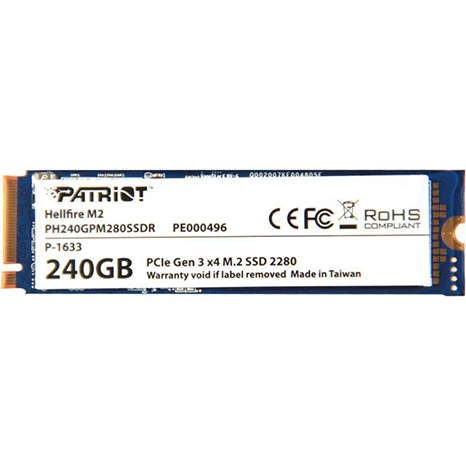
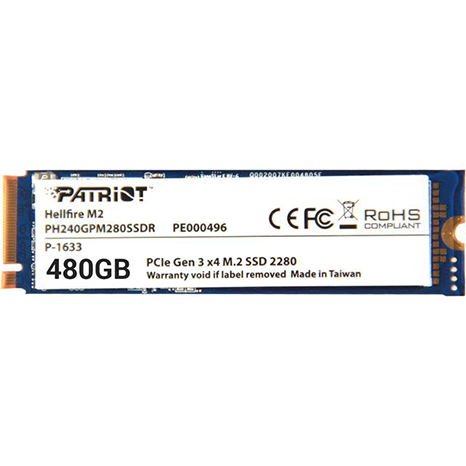
The Patriot Memory Hellfire M.2 utilizes an 8-channel Phison PS5007-E7 controller. Patriot married the controller to Toshiba planar 15nm MLC NAND flash and a low-power DDR3 DRAM buffer. Patriot released the 240GB and 480GB Hellfire SSDs at launch, but we expect to see a 1TB model ship in the future.
Patriot used off-the-shelf test tools (we call these one-click benchmarks) like ATTO and Crystal Disk Mark to spec performance. Most of these simple tools do not employ multiple workers, so the results are very close to our own testing. The Hellfire M.2 SSDs deliver up to 3,000 MB/s sequential read and 2,200 MB/s of sequential write speed. Random performance reaches up to 130,000 read IOPS and up to 210,000 write IOPS. The 240GB Hellfire delivers slightly higher random read performance and the 480GB model provides slightly better random write performance.
Get Tom's Hardware's best news and in-depth reviews, straight to your inbox.
Phison has yet to release a custom NVMe driver for any of the E7-based products. We've spoken with Phison previously about the driver situation, and the company feels the Microsoft driver is adequate. Both Intel and Samsung have released product-specific NVMe drivers to provide increased performance with their SSDs. Most performance gains come in the form of decreased read and write latency.
Features
Controller Highlights
- Compatible with PCI Express Rev. 3.0
- NVMe 1.2 Specification
- Backward Compatible with PCIe 1 and 2
- Support for 2Gb and 4Gb DDR3 DRAM
- 120bit/2KB ECC BCH
- Program RAM
- SmartECC Technology
- SmartFlush Technology
- GuaranteedFlush Technology
- Static and Dynamic Wear-Leveling
- L1.2 Power Saving Mode
- End-to-End Data Path Protection
The Phison E7 controller has a number of notable features. Phison designed the E7 specifically for Toshiba NAND, and the company tailored many of the features for high-grade MLC flash. The controller utilizes older BCH ECC and not the power-hungry, but more advanced low-density parity check (LDPC) code. Prison's proprietary technologies, such as SmartECC, SmartFlush, and GuaranteedFlush, make up the difference and work to ensure end-to-end data integrity.
Pricing
The Hellfire M.2 started shipping just after our 480GB review and pricing is both higher and lower than the MSRP we quoted in the original article. The SSD is already very popular, so Newegg's algorithm has increased the price while Amazon pricing has gone the other way. The Hellfire M.2 240GB currently sells for $172 and the 480GB retails for $296 at Amazon.
Warranty And Endurance
The Hellfire series carries a 3-year warranty that Patriot limited by the amount of data you write to the SSD, which SSD vendors spec as the Terabytes Written (TBW) measurement. The Hellfire M.2 240GB warranty ends at 115 terabytes, and the 480GB doubles endurance up to 230 terabytes.
Accessories
The Hellfire M.2 ships in a nice single-serve package that is both low cost and effective for an entry- or mainstream-level SSD. You won't find these SSDs at your local convenience store next to SD cards, but the packaging is similar. Patriot wasn't able to include any accessories in the package, but you can download the new Hellfire M.2 Toolbox software from the official product page. If your Hellfire M.2 SSD shipped with firmware 2.0, you could update the drive to the latest version for a claimed performance increase under real-world applications.
The software also allows users to view S.M.A.R.T. details of the drive as well as initiate a secure erase command if the Hellfire SSD is a secondary volume.
A Closer Look

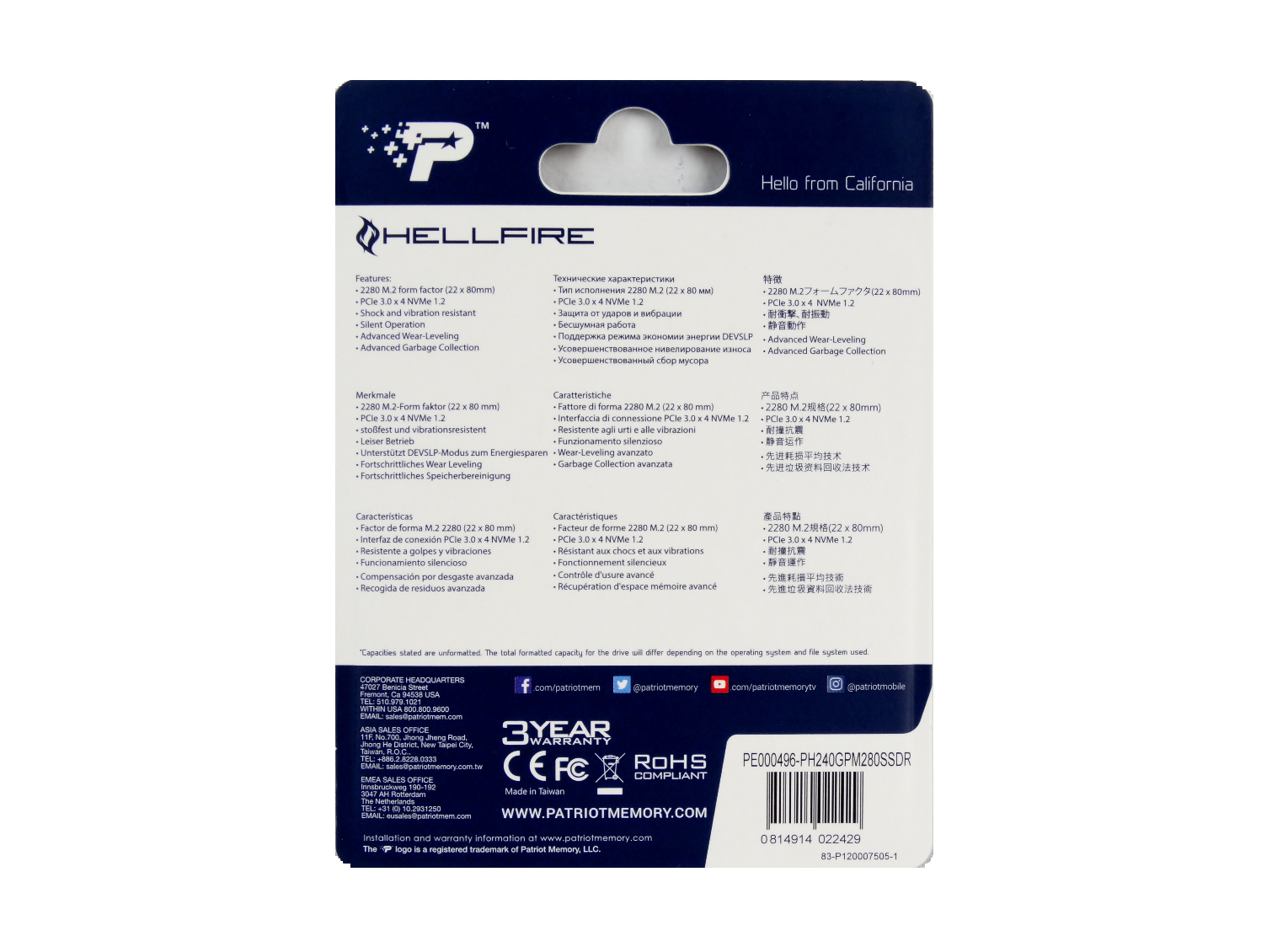
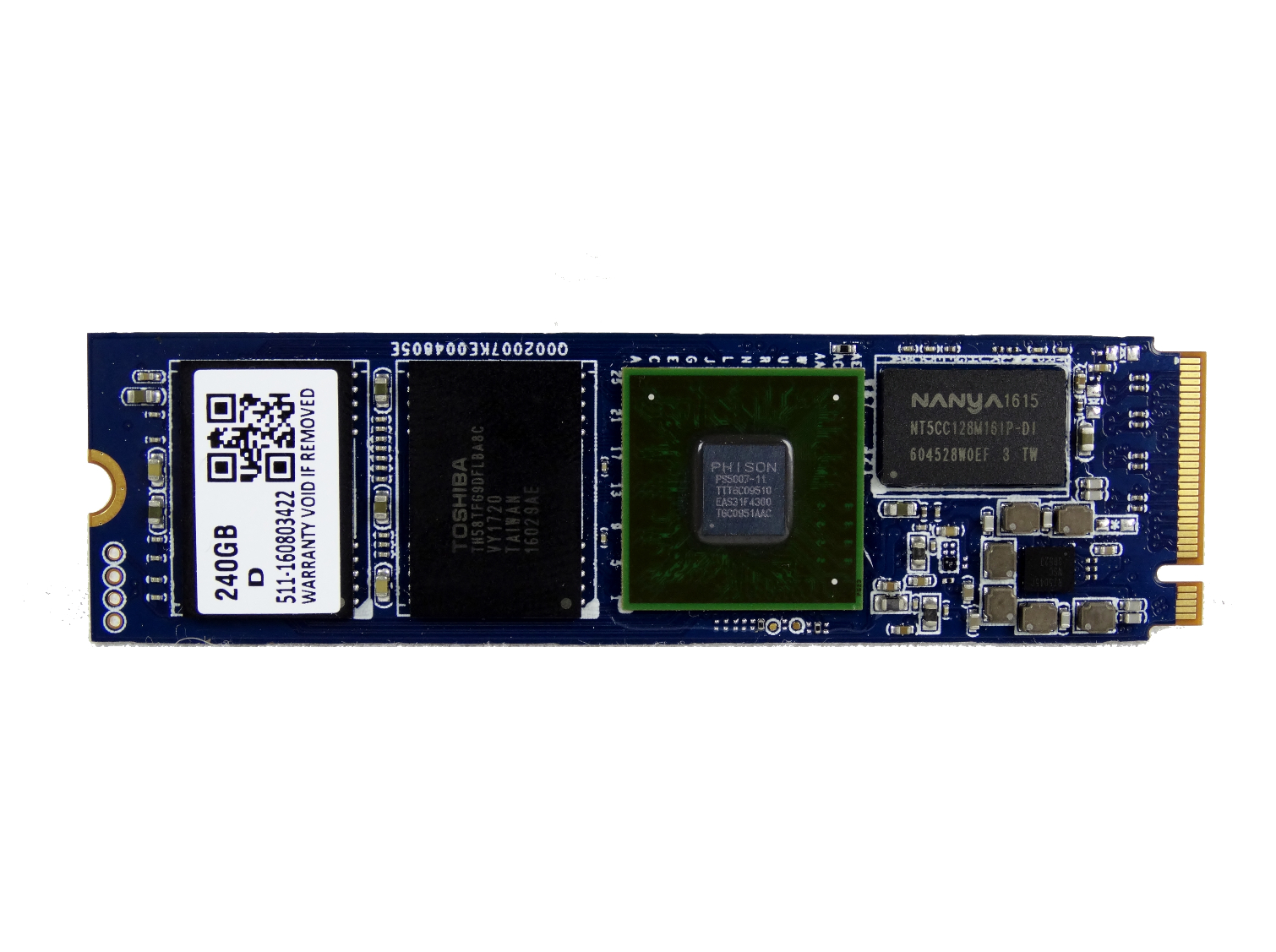
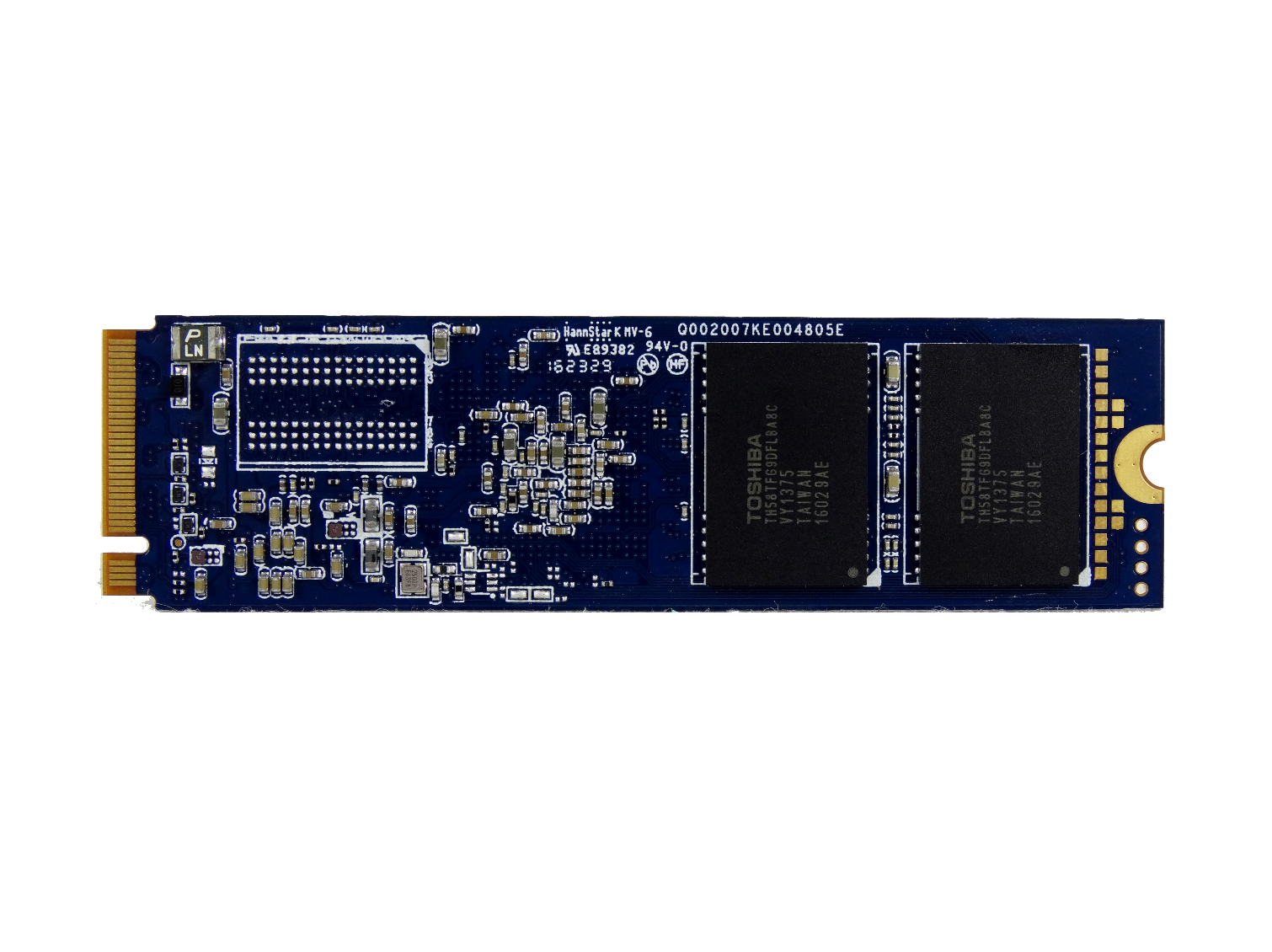
The retail package doesn't give us a great deal of insight into the Hellfire M.2. The majority of these drives will sell at online retailers and ship directly to customers, rather than you picking one up in a brick and mortar store.
The Hellfire M.2 240GB looks identical to the 480GB model we previously tested. The Phison PS5007-E7 runs cool and doesn't require a heatsink. The controller is the PCIe 3.0 x4 bridge between the host system's processor and Toshiba's 15nm MLC flash. Patriot uses a single low power DDR3 package to cache the LBA table data. The NAND comes in four packages, with two per side of the printed circuit board.
MORE: Best SSDs
MORE: Latest Storage News
MORE: Storage in the Forums

Chris Ramseyer was a senior contributing editor for Tom's Hardware. He tested and reviewed consumer storage.
-
Game256 "The Hellfire M.2 is currently the only NVMe SSD to target the middle, but that will change next month when Samsung ships the 960 EVO to resellers"Reply
The release date of Samsung 960 EVO/PRO is October. Or you know "something"? -
Game256 Another meaningless and overpriced drive. The only thing that may help all these vendors to compete with Samsung is the price but usually they constantly overstate it, making it too close to Samsung 950 Pro. Samsung is going to kill them all with 960 EVO.Reply -
Game256 Btw some Polish and German tech sites already received samples of Samsung 960 Pro so it's interesting that you didn't received them yet.Reply
https://scontent-waw1-1.xx.fbcdn.net/v/t1.0-0/s480x480/14729397_2937997012914136_7324007564864990086_n.jpg?oh=e0996b629cf74e7be362bd42809d54f2&oe=58AA4E34
https://scontent-waw1-1.xx.fbcdn.net/t31.0-8/14612499_10154535560642207_9118950000337195147_o.jpg -
Brian_R170 "The Patriot Hellfire M.2 and Intel 600p are the first products to really burst the NVMe pricing bubble." Are you speculating on future pricing? The statement is hardly true based on actual retail or suggested retail pricing. I checked the retail pricing of currently-available M.2 NVMe SSDs and all but 2 cluster together with pricing differences of less than 10%. The outliers are the Intel 600p and the Plextor M8Pe.Reply -
shrapnel_indie I guess bursting the bubble depends on the source of your part: At the beginning of the article, the viewed pricing on my end was more in competition to Samsung's M.2 PCIe offerings a few months ago. At the end of the article, it was more in-line for the mid-range to high-range SATA drives of comparable size.Reply -
JustAnITGuy PLEASE ALWAYS include a standard 7200RPM 3.5" drive and a 7200RPM 2.5" drive with ANY SSD benchmarks. The vast majority of people still have these old drives, and if this is to educate people to purchase products, It would be nice to see a side-by-side comparison and not have to go to separate benchmark articles or websites.Reply -
CRamseyer The results are so much different we can't really put them in the same chart together. Maybe in the future we will publish an article with a mainstream HDD, SSD and NVMe SSD for a comparison.Reply -
steve4king "It turns out the Patriot Hellfire M.2 is not the product we originally thought it was. After some tuning, the application performance is up and this drive is ready to take on the emerging mainstream NVMe market."Reply
What do you mean? The product you originally thought it was was based on the original firmware.. right? The 2.1 firmware is about the same, or noticeably worse than the 2.0 firmware in every bench.. -
steve4king Under sequential read performance, I think you have a typo:Reply
"The 240GB outperforms the Samsung PM961, and Intel's 600p nips at the heels of the premium Samsung 950 Pro 256GB."
I think you meant to say:
The 240GB outperforms the Samsung PM961 and Intel's 600p, and nips at the heels of the premium Samsung 950 Pro 256GB.
